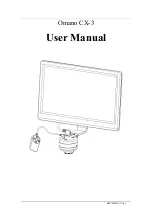
26
connections that are present and displays the results. Alternatively, you can use your PC to visually
checkout if all connections are accurate. To do this, refer to the section on “
The SureStart feature briefly reports its findings in four groups of information. These are:
Identify System
– after analyzing all the voltage and current inputs, ATPOL II identifies what type
of system is connected.
Error Summary
– after analyzing connections, the number of possible errors detected is displayed,
appearing for one second, each 6 seconds.
Identify Errors
– If errors were detected, pressing the [More] key will result in each error being
identified on the display. Press the [More] key repeatedly to advance through the list of errors.
Provide Error Diagnostic Information
– for each error message that is displayed, the background
measurements that indicate the error are displayed once each 6 seconds.
Once you have proceeded through this sequence of identifying the system and possible errors and
have corrected the problems, you can proceed knowing that the power wiring and ATPOL II
’s
connections to it are probably correct.
Identifying the Power System
After the SureStart feature is done analyzing the inputs, the type of power system that is present is
displayed on ATPOL II. Check that you agree that ATPOL II has identified the system correctly. If it
hasn’t, there is probably a problem with the system or the connections. The general types of systems
that are identified on the top line of the display are:
Single-phase
Split-phase (two-phase)
Three-phase
4-wire delta.
For each of those general systems, the display indicates whether voltages will be displayed and
recorded as phase-to-
neutral (“p-n”) or phase-to-phase (“p-p”). If the wrong voltage mode is selected, it
will not affect the power readings. If you wish to change it, use the [Measure Mode] key to do so or use
PSM to change the data logging setup.
The bottom line of the display tells the specific voltage type of the general system that has been
detected. For instance, a typical display is “277 / 480 V (p-n, p-p)”. This means the nominal voltages
present are 277 Vrms phase-neutral and 480 Vrms phase-phase. If the voltages are not of a standard
magnitude, “Non-Standard” is displayed on the second line.
Error Summary
When the display reports the type of system that is detected, it also advises, once each 6 seconds, how
many errors it suspects there are. For instance it might report “maybe 3 errors” or if all is well, it may
report “no errors detected.”
The language of these messages is not definite, because in the real world of power, there may be
many possible connection explanations for a given set of measurements. For instance, if you hook up
to a 3-phase power system, but have your current probes attached off one position to the left (that is,
the I
1
input is actually I
3
, the I
2
input is actually I
1
, and the I
3
input is actually I
2
) and each of the probes
is attached backwards, the readings that result may look correct (they will have been shifted 60
degrees). So ATPOL II
might report “no errors detected”, and with good reason, but the connections
are very incorrect. Similarly, if all of the connections are correct, but the three phase circuit has a
Содержание ATPOL II
Страница 109: ...109...
















































